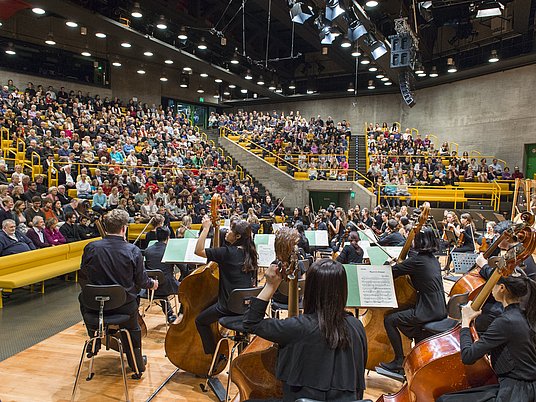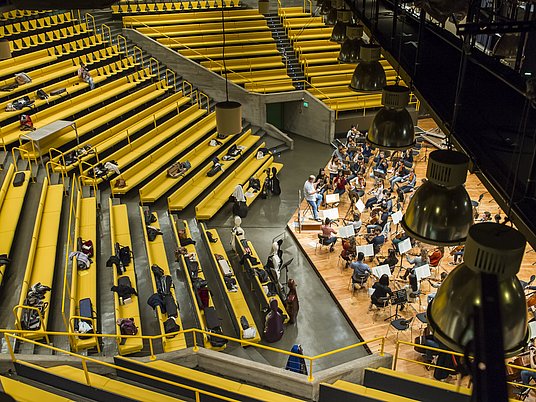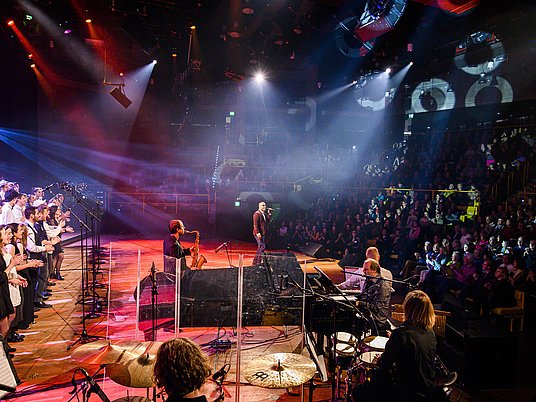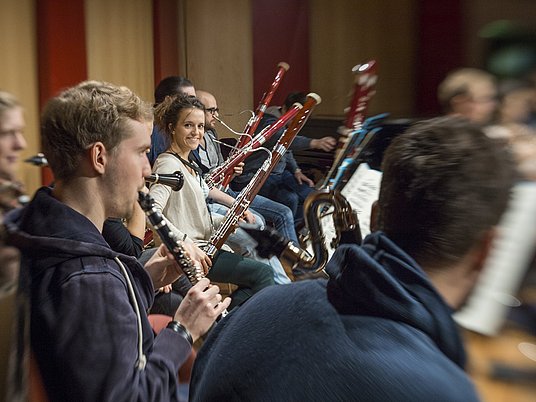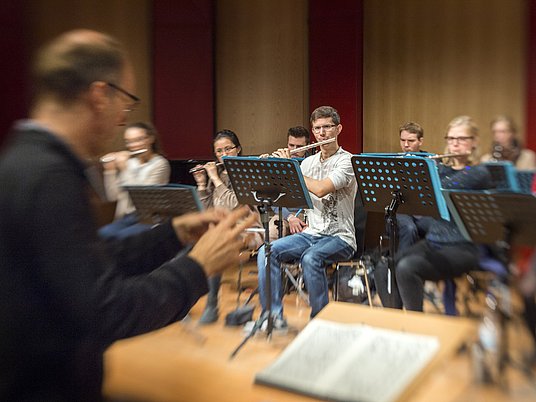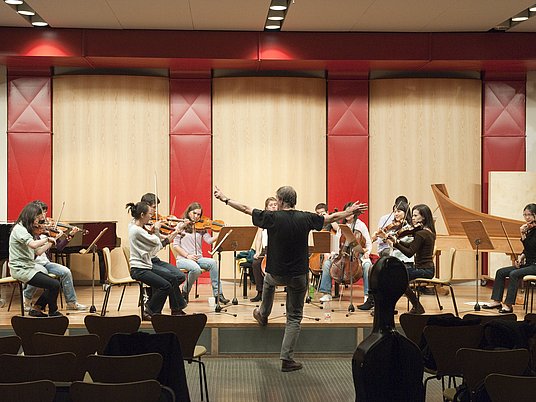Venues
Curtain up
Teaching is one thing - presenting what you have learned on stage in front of an audience is another. The Cologne University of Music and Dance offers its students several venues, ranging from large concert halls to church halls, from chamber music halls to small theaters. But the days when audiences came exclusively to us at the Hochschule are over. So we are increasingly involving external, unusual venues, breaking through boundaries and thinking of exciting and innovative ways, being open to new event concepts. Our own venues can not only be used for university productions and events, but can also be rented externally.
If you are interested in renting the concert hall or chamber music hall for your event, please fill out the application form and mail it to:
Cologne University of Music and Dance
Dezernat 3 / Künstlerisches Betriebsbüro
Unter Krahnenbäumen 87
50668 Köln

Multifunctional large stage
The concert hall of the Cologne University of Music offers the spatial and technical requirements to cover a wide spectrum of music, dance and scenic performances. Accordingly, it has a multifunctional stage, with a scenic area of 380 m², with eight podiums that can be moved steplessly against each other. The concert hall has a capacity of 799 spectators and is a large stage according to the NRW Ordinance on Places of Assembly. Furthermore, two studios are attached, a sound studio and the lighting control room.
Concert hall
- Audience seating 799
- Scene area 380m² including 100m² retractable orchestra pit
Stage
- 80 electric point hoists with 75kg load capacity each
- 17 load bars
- 1 round hoist
- Multi-span traverse above the front platform (load capacity 2to)
- 8 lifting platforms
- Variable stage portal 10-24m with electr. main curtain
- Maximum stage depth 24m
- Floor openings for power supply on the front stage
Light
Lighting
- Interlocking MA Lighting Grand MA2 Light
- 8192 parameters, 20 DMX lines
- Incl. remote control, backup computer and MA Video
- 258 fixed dimmer circuits 2kW and 5kW, additional mobile dimmer circuits
- DMX and LAN cabling, WLAN for control
- 32A and 63A connections on stage
- Circumferential lighting gallery with 3 bridges
- 2 portal towers
- 10 lane towers
Spotlights
- Niethammer profile spotlights
- Arri 2kW and 5kW stepped lens floodlights
- 24 Arri L10-C LED stepped lens floodlights
- 4 Arri Skypanel S60 LED area lights
- 4 Arri Skypanel S30 LED area lights
- 10 roller color changers for 2kW
- Stepped Lens Floodlight
- 5 roller color changers for 5kW stepped lens spotlights
- 4 Arri 2.5kW HMI stepped lens fixtures with obscurators and color changers
- 10 low voltage ramps 2,25kW
- 2x 1,2kW HMI chaser (Pani) and 2kW NV chaser
- 2kW PC lens spotlight and 1kW PAR spotlight
Moving lights
- 5 Vari*Lite VL 3000 Q washlight, 1200W HMI
- 5 Vari*Lite VL 500 A washlight, 700W MSR
- 10 Vari*Lite VL 1000 TS Spotlight, 1000W Halogen
- 2 Clay Paky Stage Profile Plus SV, 1200W HMI
- 2 Clay Paky Stage Profile 1200 SV, 1200W HMI
- 6 High End Sola Frame Theater
- 4 High End Sola Frame Studio
Projection
- 10mx8m opera foil
- 1,2kW HMI projector (Pani) for slides 18x18cm
- 1 Beamer Panasonic PL-D 6000, resolution: 1.920x1.200 WUXGA , 6500 Ansi Lumen
- 1 beamer Panasonic PT-DZ 870, resolution: 1.920x1.200 WUXGA , 8500 Ansi Lumen
- 1 Media server MA Lighting MAVideo (MA VPU), 32 Layer, 2x DVI out. 2x Video in
Sound system
Mixer
- Yamaha M7CL 48 channel (mobile)
- Yamaha LS9 32 channel (mobile)
- Soundcraft B800 (fixed with analog multicore and patch field)
Audio network
- 3 Yamaha SB 168 ES 48In/24Out (mobile)
Monitoring
- 8 pieces Audiozenit ND15 (Wedge / Multiformat)
- 6 pieces Audiozenit TI8 (Wedge / Multiformat)
- 2 pieces RAM S4044 (mobile)
- RAM RX1500, including DBX Driverack PA Controller (mobile) 4 pieces Sennheiser EW 300 IEM G2 D-BAND
PA / Mobile
- 6 pieces Audiozenit Neolite NLW212 Basses (mobile) Power handling 1200W (RMS) Sensitivity 96db Impedance 4 Ohm Frequency response (-3dB) 49-250Hz
- 6 pieces Audiozenit Neolite NL208 Tops (mobile) Power handling 600W (RMS) Sensitivity 99db Impedance 8 Ohm Frequency response (-3dB) 80-18500Hz Dispersion angle 90x60 Crossover frequency 1800 Hz
- 3 pieces Systemamping Neolite
PA / Concert Hall
Main PA
Stereo (L/C/R) consists of
- 18 Meyer Sound M1D linear array elements (9 per side)
- 4 Meyer Sound 500-HP subs (2 per side)
- 2 Meyer Sound UPJ-1P outfills (1 per side)
- 1 Meyer Sound UPQ-1P centerfill
- 4 Meyer Sound UPM-2P nearfill
The main left/right sound reinforcement system for the stalls and rising tiers in front of the stage consists of two Meyer Sound M1D line array systems, each with 9 elements and associated 500-HP subs, plus a Meyer Sound UPQ-1P loudspeaker supporting the center. The close-up area in front of the proscenium can be supported by Meyer Sound UPM-2P compact loudspeakers. The audience area next to the stage is supported by one Meyer Sound UPJ-1P active loudspeaker per side with a rotatable horn (80°x50°, or 50°x80°).
Multi-channel PA
Quadrophonic/8-channel
- 8 Meyer Sound UPQ-1P (all individually controllable)
- 4 Meyer Sound HP-500 subs from the stereo PA can be used to supplement the low bass range.
In the multi-channel PA, the loudspeakers can each be controlled individually (4-channel or 8-channel), or as quadrophony (4-channel) with "phantom center support".
All loudspeaker systems, including the subs, are controlled via a digital loudspeaker management system of the type Meyer Sound Lab. Galileo 616. All required delay times, level and phase corrections, equalizers, as well as all Meyer Sound presets were set here during calibration.
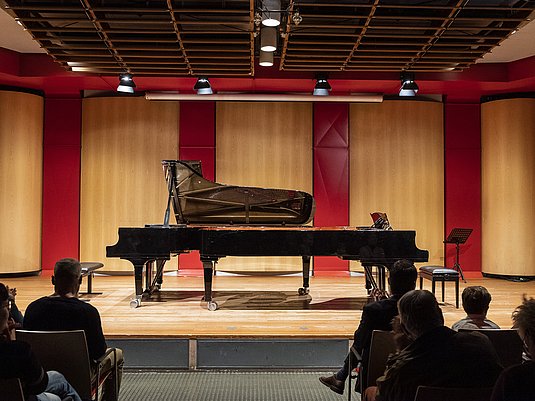
Chamber music hall with studio connection
The Chamber Music Hall of the Cologne University of Music and Dance has a seating capacity of 164 and a total area of 220 m². Attached to it is a recording studio.
Light
- Hall and stage separately dimmable
- 20 halogen stage spotlights a 150W

Classroom and event room
The Ursulines came to Cologne from Liège during the Thirty Years' War in 1639. It was not until 1651 that they received permission for permanent residence and to found the first higher girls' school in Germany. In 1671 they were able to acquire a plot of land on Machabäerstrasse. It bordered directly on the medieval city boundary, today's "Unter Krahnenbäumen", vis-à-vis the Hochschule für Musik und Tanz Köln.
In 1673, the foundation stone for the monastery was laid, exposing the floor of a Roman sanctuary and finding five altars dedicated to female deities.
The construction of the monastery church "ad cultum Divinum et honorem Venerabilis Sacramenti" was started only at the beginning of the 18th century. The Duke of Berg and Elector of the Rhenish Palatinate, Johann Wilhelm, and his second wife, the Medicean Anna Maria Lovisa of Tuscany, were patrons of the Ursulines and put their Bensberg palace architect, the Venetian Matteo Conte d'Alberti, at their disposal.
The church was completely destroyed during the Second World War, except for the outer walls and the triumphal arch. After ten years of reconstruction work, services could be celebrated in the church again from 1954.
In 1999, the Archdiocese of Cologne took over the church from the Ursulines. Extensive restoration work began. The restoration of the color scheme of the architecture, both inside and out, is indebted to Matteo Alberti's design concept. The transfer of Kolumba's baldachin altar (1703) from St. Gereon to the Ursuline Church in 2003 was essential for the spatial effect.
In the same year, the Cologne University of Music and Dance acquired an organ by Jürgen Ahrend, which was designed especially for the space. The instrument corresponds to the type of the North German baroque organ. The new construction of the organ according to historical models and the restoration of the church could be realized in cooperation with the Archbishop's General Vicariate, the Rectorate of the Ursuline School and the Ministry of Science and Research of the State of North Rhine-Westphalia.
The church has been used by the Academy of Music and Dance as a teaching and event space since the festive organ dedication on May 15, 2003. Gustav Leonhardt, Jean-Claude Zehnder and Harald Vogel were among the guests at the May concerts, along with professors from the Academy of Music.
Address
Ursulinenkirche St. Corpus Christi
Machabäerstr. 39 - 47
50668 Köln
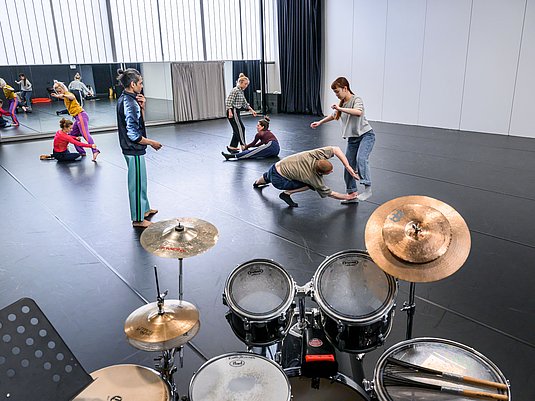
With all the possibilities for a modern dance production
The studio theater ZZT is located in the premises of the Center for Contemporary Dance in Cologne - Nippes. It regularly hosts events such as dance performances, lecture demonstrations, panel discussions, lectures and practice-oriented conferences.
- Audience seating 148
- Scene area 15m x 13,4m
Stage technology
- Multi-span truss over the scene area 14.2m X 11.6m
- 3 point truss over the stand 12m
Light
Lighting
- Interlocking ORB Zero88
- 72 dimmer circuits with 3kW
- 3 x 63A connections, 2 on stage and 1 next to spectator stand
Spotlight
- Niethammer profile spotlight 1 kW
- Strand Lighting 2kW step lens spotlight
- Strand Lighting 1kW PC spotlight
- ADB 1kW step lens spotlight
- 1kW PAr spotlight
- 2kW floodlight
- ETC Source4 750W
- Robert Juliat LPC 306 650W
- LED Ramp: RGB 1m Eurolite 252/10, 20°
- LHGL Ramp DMX dimmable RGB+W 1,2m
- 4 Strand Lighting Pirouette remote controlled step lens fixtures
- 10 lane towers equipped with 1kW stepped lens, 2x 1kW Profiler and 1kW PAR spotlight
Projection
- 1 beamer Panasonic PT-DZ 6700 E with wide angle lens, 6000 Ansi Lumen, HD - capable
- 1 beamer Liesegan D370
